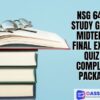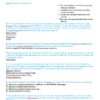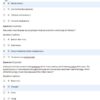Description
NSG 6420 Week 9 Quiz – Question and Answers – South
- 1.The three cardinal features of Parkinson’s disease are:
- Mr. Marshall was administer the Mini-Mental State Exam (MMSE). Which of the following statements pertaining to this tool is a true statement?
- When assessing a patient who complains of a tremor, the nurse practitioner must differentiate essential tremor from the tremor of Parkinson’s disease. Which of the following findings are consistent with essential tremor?
- An older adult client with a history of a seizure disorder comes into the clinic for a routine check-up. Although seizure-free, the client continues on long-term phenytoin treatment. The nurse practitioner would assess for which of the following long-term effects?
- An elderly patient is maintained on phenytoin therapy for a history of a seizure disorder. In addition to periodic serum drug concentrations, which of the following are needed for annual evaluation?
- Mr. Marshall was administer the Mini-Mental State Exam (MMSE). Which of the following statements pertaining to this tool is a true statement?
- An elderly patient has had a CVA in the anterior cerebral circulatory system (frontal lobe). What symptoms are most likely expressed?
- The most common neurological cause of seizures in an older adult is
- Mr. Andrews experienced a brief onset of right-sided weakness, slurred speech, and confusion yesterday. The symptoms have resolved. What should the nurse practitioner do?
- An older male patient is experiencing acute onset of right-sided weakness, slurred speech, and confusion. What should the nurse practitioner do promptly?
- When assessing an elderly client who reports a tremor, which assessment findings would be most reliable in identifying Parkinson’s disease?
- A middle-aged patient has been diagnose with Parkinson’s disease. What influences the nurse practitioner’s decision to begin pharmacological treatment for this patient?
- The Mini-Cog is a short screening tool ….to assess cognition. Which of the following statements pertaining to the test is a true statement?
- A female patient presents to the clinic with complaints of a severe, throbbing, unilateral headache. She complains of seeing flashes of light prior to the headache. She complains of sound and light sensitivity as well as nausea. The clinician should recognize these as symptoms of:
- Which of the following is a common trigger of migraine headaches?
- A 65-year-old woman is accompanied by her daughter for a physical examination. She has mild heart failure and takes digitalis and an ACE inhibitor. As you examine the patient, you note flat affect, hand tremor, and slowed movements. The tremor is worsen at rest. There are no neurologic deficits. Handgrip, the sensation of face and extremities, and lower extremity muscle strength are within normal limits and bilaterally equal. DTRs are equal bilaterally. CN II to XII are intact. The mental status exam is normal. These are key signs of nsg 6420 week 9 quiz
- A 65-year-old male complains of a headache that feels “like a knife is cutting into his head.” He also reports feeling right-sided scalp and facial pain and “seeing double” at times. He has a history of hypertension and hyperlipidemia. His medications include beta-blockers, a statin drugs, and an ACE inhibitor. On physical examination, you note palpable tenderness over the right side of the forehead. There are no neurological deficits. Vision is 20/20 with lenses. No weakness of extremities. CN II to XII is intact. The history corresponds to which of the following disorders?
- Which type of seizure is….following a head injury or febrile event?
- M. L. is a 40-year-old female that has been recently ….with Multiple Sclerosis (MS). As you provide primary care for your patient you inform her that:
- Ms. Smith, 37-year-old, comes to the clinic today complaining of dull, throbbing bilateral headaches almost every evening. You suspect she is experiencing:
- The FNP is seeing Mr. Smith a 78-year-old gentleman accompanied by his wife to the health clinic. His wife reports that he has been falling down, tripping and stumbling. The FNP suspects a problem in:
- Educating your patient about headache management should include information about all but:








